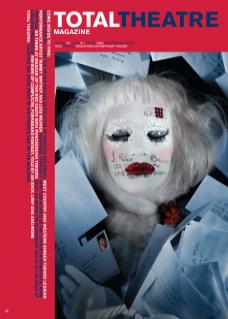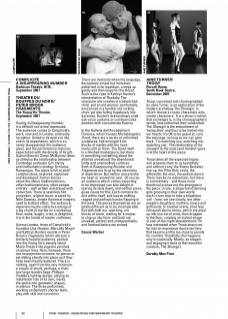Seeing A Disappearing Number, it is difficult not to feel impressed. The audience comes to Complicité’s work, now and in London, eminently receptive. United in its desire to like, and in its expectation, which is so rarely disappointed, the audience gives, and the performance matches expectation with the density of its gift. Auteur/director Simon McBurney takes as stimulus the relationship between Cambridge professor G.H. Hardy and mathematics prodigy Srinivasa Ramanujan. The piece is full of stuff: complex ideas, explored, explained and developed; human stories – about the above mathematicians, other mathematicians, other people entirely – well written and played with conviction. There is seamless film projection, original music created by Nitin Sawney, simple theatrical imagery used to brilliant effect. The audience, experiencing the collective energy of a big chunk of marble on a workshop floor, waits, laughs, cries, is delighted; it is in the hands of master craftsmen.
Across London, three of Complicité’s founders (Jos Houben, Marcello Magni and Kathryn Hunter) reunite in Peter Brook’s Fragments, which attracts a similarly hopeful audience, packed into the Young Vic’s steeply raked Maria Theatre like pigeons perched on power lines. Here, however, there are no projection screens, no pieces of set sliding silently into place as if they have been freshly buttered. There is nothing, apart from the very minimum: a couple of stools, perhaps; a chair; two large laundry bags. Philippe Vialette’s lighting design, playing an installation role of its own, marks the space into geometric shapes, in silence. The three performers, working on Beckett’s shorter texts, play with skill and conviction.
There are moments when the language, deceptively simple but intricately patterned in its repetition, creeps up gently and then leaps for the throat. Such is the case in Kathryn Hunter’s interpretation of Rockaby. The character she creates is a bewitched child, and an old woman; comfortably ensconced in a familiar old rocking chair, yet also falling hopelessly into darkness. Hunter’s extraordinary oiledoak voice contains or communicates emotion with consummate fluency.
In the Galleria dell’Accademia in Florence, which houses Michelangelo’s David, there are a series of unfinished sculptures, half emerged from blocks of marble with the hackmarks still on them. The David itself is a finished masterpiece, but there is something compelling about the attempt unrealised; the abandoned limbs and unsmoothed surfaces. Both A Disappearing Number and Fragments are lit up by the electricity of experience. But neither piece broke my heart or seared my soul. Of course, an audience which comes expecting to be impressed can also delight in tearing its idols down, and neither piece gives cause for this. Each contains its end within itself, and leaves nothing ragged and perhaps human flapping in the wind. The pieces themselves are so totally different as to be incomparable. But with both we, watching, are blocks of stone, waiting for a master to chip us into form; and both are unveiled, perfect and unimpeachable, and finished before we arrived.

